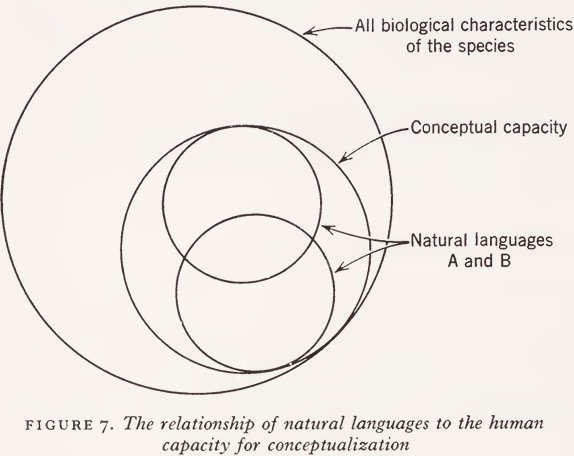
Postscript to so-called language relativity
 المؤلف:
ERIC H. LENNEBERG
المؤلف:
ERIC H. LENNEBERG
 المصدر:
Semantics AN INTERDISCIPLINARY READER IN PHILOSOPHY, LINGUISTICS AND PSYCHOLOGY
المصدر:
Semantics AN INTERDISCIPLINARY READER IN PHILOSOPHY, LINGUISTICS AND PSYCHOLOGY
 الجزء والصفحة:
553-30
الجزء والصفحة:
553-30
 2024-08-25
2024-08-25
 1127
1127
Postscript to so-called language relativity
The term language relativity is due to B. L. Whorf, although similar notions had been expressed before by many others (Basilius, 1952). In his studies of American Indian languages, Whorf was impressed with the general difficulties encountered in translating American Indian languages into European languages. To him there seemed to be little or no isomorphism between his native English and languages such as Hopi or Nootka. He posed the question, as many had done before him, of whether the divergences encountered reflected a comparable divergence of thought on the part of the speakers. He left the final answer open, subject to further research, but it appears from the tenor of his articles that he believed that this was so, that differences in language are expressions of differences in thought. It has been pointed out since (Black, 1959; Feuer, 1953; but see also Fishman, 1960) that there is actually little a priori basis for such beliefs.
The empirical research (partly stimulated by Whorf’s own imaginative ideas) indicate that the cognitive processes studied so far are largely independent from peculiarities of any natural language and, in fact, that cognition can develop to a certain extent even in the absence of knowledge of any language. The reverse does not hold true; the growth and development of language does appear to require a certain minimum state of maturity and specificity of cognition. Could it be that some languages require ‘less mature cognition’ than others, perhaps because they are still more primitive? In recent years this notion has been thoroughly discredited by virtually all students of language. It is obvious that on the surface every language has its own peculiarities but it is possible, in fact assumed throughout this monograph, that languages are different patterns produced by identical basic principles (much the way sentences are different patterns - in¬ finitely so - produced by identical principles). The crucial question, therefore, is whether we are dealing with a universal and unique process that generates a unique type of pattern. This appears to be entirely possible. In syntax we seem to be dealing always with the same formal type of rule and in the realm of semantics we have proposed that the type of relationship between word and object is quite invariant across all users of words. It is due to this uniformity that any human may learn any natural language within certain age limits.
When language learning is at its biological optimum, namely in childhood, the degree of relatedness between first and second language is quite irrelevant to the ease of learning that second language. Apparently, the differences in surface structure are ignored and the similarity of the generative principles is maximally explored at this age. Until rigorous proof is submitted to the contrary, it is more reasonable to assume that all natural languages are of equal complexity and versatility and the choice of this assumption detracts much from the so-called relativity theory.

Since the use of words is a creative process, the static reference relationships, such as are apparent through Approach A or as they are recorded in a dictionary, are of no great consequence for the actual use of words. However, the differences between languages that impressed Whorf so much are entirely restricted to these static aspects and have little effect upon the creative process itself. The diagram of Fig. 7 may illustrate the point. Common to all mankind are the general biological characteristics of the species (outer circle) among which is a peculiar mode and capacity for conceptualization or categorization. Languages tag some selective cognitive modes but they differ in the selection. This selectivity does not cripple or bind the speaker because he can make his language, or his vocabulary, or his power of word-creation, or his freedom in idiosyncratic usages of words do any duty that he chooses, and he may do this to a large extent without danger of rendering himself unintelligible because his fellow men have similar capacities and freedoms which also extend to understanding.
 الاكثر قراءة في Semantics
الاكثر قراءة في Semantics
 اخر الاخبار
اخر الاخبار
اخبار العتبة العباسية المقدسة


